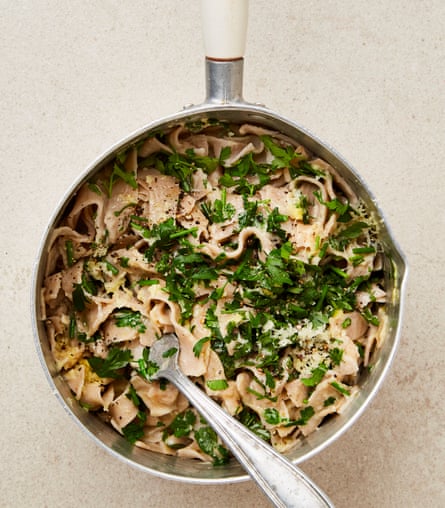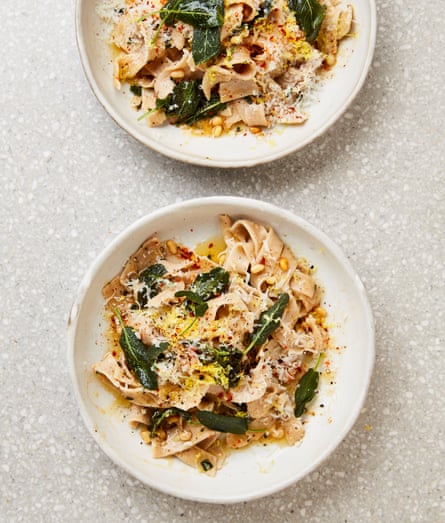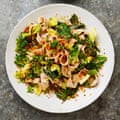
I could eat pasta every day of the year, and there are so many varieties out there that I could probably eat a different type every day as well. All too often, though, I default to the big-hitters – linguine, penne, spaghetti – and all too often I buy it in rather than make it from scratch. If you’re in the same pasta boat (or bowl), I hope today’s recipes inspire you to make your own, not least because there’s no pasta machine required. Pasta that’s made mainly with buckwheat flour will be a revelation to those who are new to it: it is nutty, toothsome and hearty.
Pizzoccheri
Pizzoccheri is a type of buckwheat tagliatelle from northern Italy, and needs little more than some butter and grated cheese to highlight its chewy, nutty texture. If you want to get ahead, make the dough a day beforehand, then refrigerate and roll out just before cooking.
Prep 10 min
Rest 10 min
Cook 3 min
Makes 650g pasta, to serve 4
250g buckwheat flour, plus extra for dusting
170g ‘00’ flour
Fine sea salt
To serve
60ml olive oil, or 80g butter
60g fontina or gruyere, grated
30g soft herb leaves – parsley and/or oregano would work well
Black pepper
Mix both flours in a large bowl with a teaspoon of salt. Make a well in the centre of the flour mixture, then pour in 220ml room-temperature water, mix in well, then knead for five minutes, until you have a smooth dough. Cover with a cloth and set aside for 10 minutes.
Roll the dough into a 24cm-long sausage, then cut this into three 8cm-long pieces. Generously flour a work surface with buckwheat flour, then roll each piece of dough into a rough 30cm x 45cm rectangle that’s about 2-3mm thick. With the long side facing you, fold over one of the rectangles twice, so it now has three layers, then cut widthways into 1cm-wide ribbons. Put these on a tray, cover with a cloth to stop them drying out, and repeat with the remaining two dough rectangles.
Bring a large saucepan of well-salted water to a boil. Turn down the heat to medium-high, shake any excess flour off half the pasta ribbons, then drop into the pot and stir gently with the handle of a wooden spoon to stop them clumping together. Cook for two or three minutes, until cooked to al dente, then, using a large slotted spoon or spider, lift out into a large colander set over a large bowl. Bring the water back to a boil, repeat with the remaining pasta, and save two tablespoons of the pasta cooking water.
Put the oil or butter in a wide, heavy-based, medium-sized saucepan on a medium-high heat, add all the pizzoccheri and the reserved pasta water, and stir gently to coat and combine. Off the heat, sprinkle over the cheese and herbs, and serve topped with lots of freshly ground black pepper.
Pizzoccheri with lemon burnt butter and crisp sage

The abundance of butter and parmesan in this dish makes the already comforting pizzoccheri very hearty indeed. If you like, use shop-bought dried pizzoccheri or another tagliatelle-like pasta instead of making them fresh, and cook according to the packet instructions.
Prep 25 min
Cook 30 min
Serves 4
45ml olive oil
20g sage leaves
100g unsalted butter
30g pine nuts
2 garlic cloves, peeled and crushed
Fine sea salt and black pepper
650g just-cooked pizzoccheri (see above)
2 lemons, zest finely grated, to get 1 tbsp, then juiced, to get 45ml
20g grated parmesan
1½ tsp aleppo chilli flakes, or 1 tsp regular chilli flakes
Put the oil in a small saucepan on a medium heat and, once it’s hot, fry the sage in three batches until translucent and crisp. Using a slotted spoon, transfer to a plate lined with kitchen paper; save the oil for later.
Put the butter in a large saute pan on a medium-high heat and cook for six to seven minutes, until it’s foaming and starting to smell nutty. Take off the heat, add the pine nuts and cook for a minute in the residual heat. Stir in the garlic, return the pan to a medium-high heat, spoon in two tablespoons of the pasta cooking water and a quarter-teaspoon of salt, then add the cooked pasta, toss to coat and take off the heat.
Stir in the lemon juice and crumble in half the crisp sage leaves, then lift on to four plates or shallow bowls and top with grated parmesan. Scatter over the lemon zest followed by a good grind of pepper and the chilli flakes, drizzle with the reserved sage oil and serve with the remaining whole sage leaves scattered on top.
Pizzoccheri with miso cabbage and spiced breadcrumbs

This recipe uses only half the amount of pasta as today’s first recipe; make and roll it in the exact same way. The soft, buttery cabbage makes this even more comforting.
Prep 25 min
Cook 20 min
Serves 2
325g fresh pizzoccheri (ie, half the amount made in the first recipe, so made with 125g buckwheat flour, 85g ‘00’ flour, ½ tsp salt and 110ml room-temperature water)
For the breadcrumbs
1½ tbsp olive oil
30g panko breadcrumbs
1½ tsp caraway seeds, lightly crushed in a mortar
2 tsp aleppo chilli flakes
2 tsp lemon zest
Salt and black pepper
For the cabbage
100ml olive oil
5 garlic cloves, peeled and crushed
2½ tbsp white miso paste
450g savoy cabbage (or other cabbage of your choice), trimmed and cut into 2cm chunks
1 bunch spring onions (125g), 30g of the green part cut into thin rounds, the rest cut into 3cm lengths
2 tbsp lemon juice
First make the pasta as in the first recipe. For the breadcrumbs, put the oil in a small frying pan on a medium heat and, once hot, add the panko and fry for two to three minutes, until golden. Stir in the caraway seeds, toast for a further minute, then take off the heat and stir in the chilli, lemon zest and a sprinkle of salt. Tip into a bowl and leave to cool.
To make the cabbage, put the oil, garlic and miso in a large saucepan on a medium-high heat and cook, stirring often, for two or three minutes, until fragrant. Stir in the cabbage and 95g of the spring onion whites, and cook for another six to eight minutes, until softened and buttery.
Meanwhile, bring a medium saucepan of well-salted water to a boil. Reduce the heat to medium-high, add the pizzoccheri, stir gently with the handle of a wooden spoon to prevent clumping and cook for two to three minutes, or until al dente and just starting to rise to the surface of the water. Using a large slotted spoon, lift the pizzoccheri and a tablespoon or two of their cooking water into the cabbage pan, and shake the pan to toss and coat the pasta in the sauce.
Off the heat, drizzle over the lemon juice, then scatter on a third of the breadcrumb mix and the sliced spring onion greens. Lift into two bowls and serve hot with the remaining breadcrumbs on the side.


